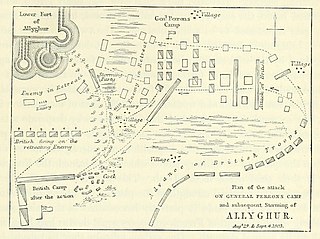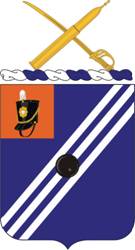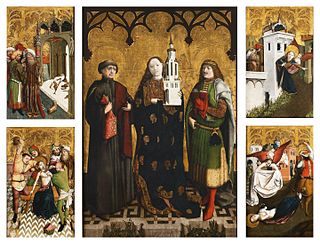
A trebuchet is a type of catapult that uses a rotating arm with a sling attached to the tip to launch a projectile. It was a common powerful siege engine until the advent of gunpowder. The design of a trebuchet allows it to launch projectiles of greater weights and further distances than that of a traditional catapult.

The Third Battle of Ypres, also known as the Battle of Passchendaele, was a campaign of the First World War, fought by the Allies against the German Empire. The battle took place on the Western Front, from July to November 1917, for control of the ridges south and east of the Belgian city of Ypres in West Flanders, as part of a strategy decided by the Allies at conferences in November 1916 and May 1917. Passchendaele lies on the last ridge east of Ypres, 5 mi (8 km) from Roulers, a junction of the Bruges-(Brugge)-to-Kortrijk railway. The station at Roulers was on the main supply route of the German 4th Army. Once Passchendaele Ridge had been captured, the Allied advance was to continue to a line from Thourout to Couckelaere (Koekelare).

The Battle of Verdun was fought from 21 February to 18 December 1916 on the Western Front in France. The battle was the longest of the First World War and took place on the hills north of Verdun-sur-Meuse. The German 5th Army attacked the defences of the Fortified Region of Verdun and those of the French Second Army on the right (east) bank of the Meuse. Using the experience of the Second Battle of Champagne in 1915, the Germans planned to capture the Meuse Heights, an excellent defensive position, with good observation for artillery-fire on Verdun. The Germans hoped that the French would commit their strategic reserve to recapture the position and suffer catastrophic losses at little cost to the German infantry.

The Royal Regiment of Artillery, commonly referred to as the Royal Artillery (RA) and colloquially known as "The Gunners", is one of two regiments that make up the artillery arm of the British Army. The Royal Regiment of Artillery comprises thirteen Regular Army regiments, the King's Troop Royal Horse Artillery and five Army Reserve regiments.

Trench warfare is a type of land warfare using occupied lines largely comprising military trenches, in which combatants are well-protected from the enemy's small arms fire and are substantially sheltered from artillery. It became archetypically associated with World War I (1914–1918), when the Race to the Sea rapidly expanded trench use on the Western Front starting in September 1914.

The siege of Aligarh also known as the Battle of Aligarh was fought between the Maratha Confederacy and the British East India Company during the Second Anglo-Maratha War (1803–1805) at Aligarh, India.

The 42 centimetre kurze Marinekanone 14 L/12, or Minenwerfer-Gerät (M-Gerät), popularly known by the nickname Big Bertha, was a German siege howitzer built by Krupp AG in Essen, Germany and fielded by the Imperial German Army from 1914 to 1918. The M-Gerät had a 42 cm (17 in) calibre barrel, making it one of the largest artillery pieces ever fielded.

The Ordnance QF 25-pounder, or more simply 25-pounder or 25-pdr, with a calibre of 3.45 inches (87.6 mm), was a piece of field artillery used by British and Commonwealth forces in the Second World War. Durable, easy to operate and versatile, it was the most produced and used British field gun and gun-howitzer during the war.

A railway gun, also called a railroad gun, is a large artillery piece, often surplus naval artillery, mounted on, transported by, and fired from a specially designed railway wagon. Many countries have built railway guns, but the best-known are the large Krupp-built pieces used by Germany in World War I and World War II. Smaller guns were often part of an armoured train. They were only able to be moved where there were good tracks, which could be destroyed by artillery bombardment or airstrike. Railway guns were phased out after World War II.

An artillery tractor, also referred to as a gun tractor, is a specialized heavy-duty form of tractor unit used to tow artillery pieces of varying weights and calibres. It may be wheeled, tracked, or half-tracked.

The bombard is a type of cannon or mortar which was used throughout the Late Middle Ages and the early modern period. Bombards were mainly large calibre, muzzle-loading artillery pieces used during sieges to shoot round stone projectiles at the walls of enemy fortifications, enabling troops to break in. Most bombards were made of iron and used gunpowder to launch the projectiles. There are many examples of bombards, including Mons Meg, the Dardanelles Gun, and the handheld bombard.
The Model 1840 light artillery saber was a saber of about 42 inches in length with a curved, single-edged blade and iron scabbard.

The Canon de 105 L modèle 1936 Schneider was a field gun used by France in World War II.

Suippes is a commune in the Marne department in north-eastern France. It was part of the so-called la Champagne pouilleuse, a region battered by conflict during World War I. In the early months of the war, British soldiers were deployed here and were to march to Châlons-sur-Marne to fight the First Battle of the Marne. In October 1918, the United States also deployed a brigade in the area and was assigned as Fourth French Army reserve. The commune was pillaged and razed by the Germans in the same way they attacked Heiltz-le-Maurupt, Marfaux, Fromentieres, and Esternay.

Beaufort-en-Argonne is a commune in the Meuse department in the Grand Est region in northeastern France.

The 41st Field Artillery Regiment is a field artillery regiment of the United States Army.

The 76th Field Artillery Regiment is a field artillery regiment of the United States Army. First formed as a cavalry regiment in 1916, the regiment was converted to field artillery in 1917, and served in Europe during World War I with the 3rd Division and as a separate battalion during World War II, as well as in peacetime at Fort Knox, KY, and Fort Devens, MA. Since 1959, the regiment has been a parent regiment under the Combat Arms Regimental System and the U.S. Army Regimental System, with regimental elements serving with the 3rd Infantry Division in Germany and Operation Iraqi Freedom, with the 7th Infantry Division in Korea, and in the Army Reserve. No regimental elements are currently active.

Saint Barbara, known in the Eastern Orthodox Church as the Great Martyr Barbara, was an early Christian Greek saint and martyr. There is no reference to her in the authentic early Christian writings nor in the original recension of Saint Jerome's martyrology.

Wei Fenghe is a retired general in the People's Liberation Army (PLA) who served as commander of the PLA Rocket Force, formerly known as the Second Artillery Corps. From 2018 to 2023, he was the Minister of National Defense, the first to have not come from the PLA Ground Forces and the first-ranked State Councilor from March 2018 to March 2023, and also the first-ranked ordinary Member of the Central Military Commission (CMC).


















